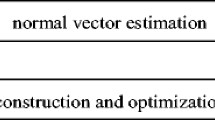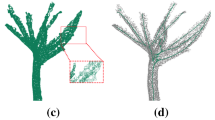Abstract
A key step in processing natural trees from point cloud data is to reconstruct the trees’ skeleton, which plays an important role in forest investigation and monitoring. Although the techniques for general objects skeletonizing based on point clouds have made a large stride, there are few efficient and simple studies on the natural trees, which have complex topologies. In this paper, we propose a novel method to reconstruct tree skeletons based on the point cloud data, named as the force field driven tree skeleton extracting method, which consists of the following steps. Specifically, to make the point cloud tree a little bit cleaner, the hierarchical subdivision to the original point cloud space is firstly proposed. Then the split-level of the trees’ applied space is considered in each layers, and a simplified representation of the feature points for the tree model is then established under the neighbor relationships. After that, the feature points in the peripheral are connected by the geodesic distance. To get the initial skeleton, the surface geodesic lines are compressed into the tree model by applying a visible repulsive force field. Finally, the final skeleton is acquired by polishing the initial skeleton according to a threshold setting. The experimental results on two kinds of representative naturally growing trees, which are the Cherry and Michelia, indicate that this method can provide a satisfactory performance.








Similar content being viewed by others
References
Aiteanu F, Klein R (2014) Hybrid tree reconstruction from inhomogeneous point clouds. Vis Comput 30:763–771
Amenta N, Bern M, Kamvysselis M (1998) A new voronoi-based surface reconstruction algorithm. In: Proceedings of the 25th annual conference on computer graphics and interactive techniques. ACM, pp 415–421
Amenta N, Choi S, Kolluri RK (2001) The power crust. In: Proceedings of the sixth ACM symposium on solid modeling and applications. ACM, pp 249–266
An Y, Li Z, Shao C (2013) Feature extraction from 3d point cloud data based on discrete curves. Math Probl Eng 2013:1–19
Balzer J, Vincze M (2016) Modeling connected regions in arbitrary planar point clouds by robust B-spline approximation. North-Holland Publishing Co
Bradshaw G, Osullivan C (2004) Adaptive medial-axis approximation for sphere-tree construction. ACM Trans Graph 23(1):1– 26
Bucksch A, Lindenbergh RC, Menenti M (2010) Skeltre: robust skeleton extraction from imperfect point clouds. Vis Comput 26(10):1283–1300
Burt A, Disney M, Raumonen P, et al. (2013) Rapid characterisation of forest structure from tls and 3d modelling. In: Proceedings international geoscience and remote sensing symposium (IGARSS 2013), pp 3387–3390
Chu C-T, Chiang H-K, Chang Y-S (2016) Clustering algorithms applied gaussian basis function neural network compensator with fuzzy control for magnetic bearing system. In: 2016 the 5th international symposium on next-generation electronics (ISNE). IEEE, pp 1–2
Deliormanli AH, Maerz NH, Otoo J (2014) Using terrestrial 3d laser scanning and optical methods to determine orientations of discontinuities at a granite quarry. Int J Rock Mech Mining Sci 66:41–48
Djuricic A, Puttonen E, Harzhauser M, et al. (2016) 3d central line extraction of fossil oyster shells. ISPRS Ann Photogrammetry Remote Sens Spatial Inf Sci 3(5)
Dong Z, Ting Y, Xue L, et al. (2015) Skeleton extraction for real trees. Int J Advancements Comput Technol 7(4):22
Ducey MJ, Astrup R (2013) Adjusting for nondetection in forest inventories derived from terrestrial laser scanning. Can J Remote Sens 39(5):410–425
Eckart BD, Kim K, Troccoli AJ et al (2016) Modeling point cloud data using hierarchies of gaussian mixture models. US Patent App. 15/055,440
Gottschalk S, Lin MC, Manocha D (1996) Obbtree: a hierarchical structure for rapid interference detection. In: International conference on computer graphics and interactive techniques, pp 171–180
Huang H, Wu S, Cohenor D, et al. (2013) L 1 -medial skeleton of point cloud. Int Conf Comput Graph Interact Techn 32(4):65
Kandare K, Orka HO, Dalponte M, et al. (2017) Individual tree crown approach for predicting site index in boreal forests using airborne laser scanning and hyperspectral data. Int J Appl Earth Observ Geoinform 60:72–82
Kankare V, Puttonen E, Holopainen M, et al. (2016) The effect of tls point cloud sampling on tree detection and diameter measurement accuracy. Remote Sens Lett 7(5):495–502
Kim J, Kim D, Cho H (2013) Procedural modeling of trees based on convolution sums of divisor functions for real-time virtual ecosystems. Comput Anim Virtual Worlds 24:237–246
Lamb SM, MacLean DA, Hennigar CR, et al. (2018) Forecasting forest inventory using imputed tree lists for lidar grid cells and a tree-list growth model. Forests 9(4):165
Liao Q, Guan N, Zhangg Q (2016) Gauss-seidel based non-negative matrix factorization for gene expression clustering. In: 2016 IEEE international conference on acoustics, speech and signal processing (ICASSP). IEEE, pp 2364–2368
Lidayov K, Frimmel H, Wang C et al (2016) Fast vascular skeleton extraction algorithm
Lindberg F (2016) Peer review report on “retrieval of three-dimensional tree canopy and shade using terrestrial laser scanning (tls) data to analyze the cooling effect of vegetation”. Agr Forest Meteorol 9(217):125
Livny Y, Yan F, Olson M, et al. (2010) Automatic reconstruction of tree skeletal structures from point clouds. Int Conf Comput Graph Interact Tech 29(6):151
Maltamo M, Bollandss OM, Gobakken T, et al. (2016) Large-scale prediction of aboveground biomass in heterogeneous mountain forests by means of airborne laser scanning. Can J Forest Res 46(9):1138–1144
Mikita T, Janata P, Surovy P (2016) Forest stand inventory based on combined aerial and terrestrial close-range photogrammetry. Forests 7(8):165
Shlyakhter I, Rozenoer M, Dorsey J, et al. (2001) Reconstructing 3d tree models from instrumented photographs. IEEE Comput Graph Appl 21(3):53–61
Su J, Bai H, Zhang P, et al. (2016) Intentional islanding algorithm for distribution network based on layered directed tree model. Energies 9(3):1–21
Su Z, Zhao Y, Zhao C, et al. (2011) Skeleton extraction for tree models. Math Comput Model 54 (3):1115–1120
Urbach JM (2014) Efficiently implementing and displaying independent 3-dimensional interactive viewports of a virtual world on multiple client devices. US Patent 8,817, 025
Wallace L, Lucieer A, Malenovsky Z, et al. (2016) Assessment of forest structure using two uav techniques: a comparison of airborne laser scanning and structure from motion (sfm) point clouds. Forests 7(3):1–16
Wang C, Han D, Yang K (2008) L-system modeling based on trees’ synthetic characteristics. In: International symposium on computational intelligence and design, pp 87–90
Wang Z, Zhang L, Fang T, et al. (2014) A structure-aware global optimization method for reconstructing 3-d tree models from terrestrial laser scanning data. IEEE Trans Geosci Remote Sens 52(9):5653–5669
Wang Y, Hyyppa J, Liang X, et al. (2016) International benchmarking of the individual tree detection methods for modeling 3-d canopy structure for silviculture and forest ecology using airborne laser scanning. IEEE Trans Geosci Remote Sens 54(9):5011–5027
Wu J, Zhang G, Xia J, et al. (2010) Gray cerebrovascular image skeleton extraction algorithm using level set model. J Multimed 5(3):208–215
Xie K, Yan F, Sharf A, et al. (2016) Tree modeling with real tree-parts examples. IEEE Trans Visual Comput Graph 22(12):2608–2618
Zhang D, Liu J, Xue L, et al. (2016a) Tree canopy image segmentation based on ncspso-afsa optimization of svm. J Northwest Agri Sci Technol Univ: Natural Sci Edn 44(3):118–124
Zhang D, Yan R, Yun T, et al. (2016b) The modeling method based on the ground laser radar chanmu branches. J Forest Eng 1(5):107–114
Zhou G, Wang B, Zhou J (2014) Automatic registration of tree point clouds from terrestrial lidar scanning for reconstructing the ground scene of vegetated surfaces. IEEE Geosci Remote Sens Lett 11(9):1654–1658
Zhou G, Cao S, Sun Z (2015) Automatic registration of tree point clouds from terrestrial laser scanning. In: 2015 IEEE international, geoscience and remote sensing symposium (IGARSS). IEEE, pp 561–564
Acknowledgements
This work was supported by the National Natural Science Foundation of China (31670554), the Natural Science Foundation of Jiangsu Province (BK20161527), the Central Public-interest Scientific Institution Basal Research Fund (CAFYBB2016SZ003) and the Postgraduate Research & Practice Innovation Program of Jiangsu Province (KYCX17_0819).
Author information
Authors and Affiliations
Corresponding author
Additional information
Communicated by: H. A. Babaie
Publisher’s Note
Springer Nature remains neutral with regard to jurisdictional claims in published maps and institutional affiliations.
Rights and permissions
About this article
Cite this article
Gao, L., Zhang, D., Li, N. et al. Force field driven skeleton extraction method for point cloud trees. Earth Sci Inform 12, 161–171 (2019). https://doi.org/10.1007/s12145-018-0365-3
Received:
Accepted:
Published:
Issue Date:
DOI: https://doi.org/10.1007/s12145-018-0365-3




